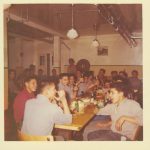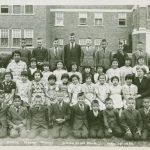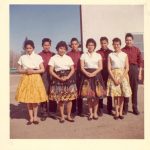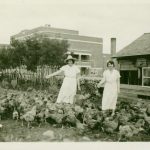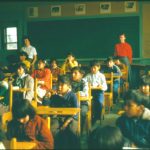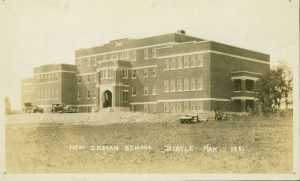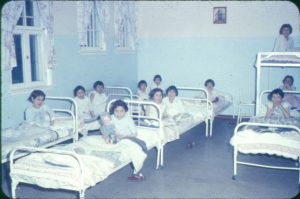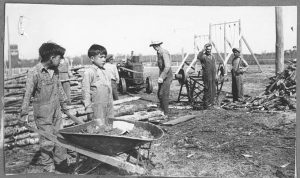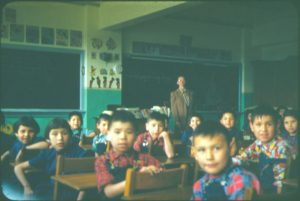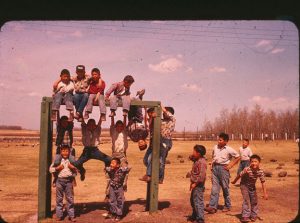Birtle School
This web-exhibit contains content that may be triggering for some researchers. If you are a Residential School Survivor in need of support, please contact the 24-Hour National Crisis Line: 1-866-925-4419.
In 1888 The Presbyterian Church in Canada, in partnership with the Canadian federal government, opened a Residential School in Birtle, Manitoba. Although a nearby day-school had been in operation since 1884, it was closed to promote enrollment in the new Residential School program. While the day school had allowed students to reside with their families and home communities, the Residential School was a boarding program in which students lived at Birtle school for the majority of the year, and returned home over the Christmas and Summer breaks (Bush, 2004, p.2).
While the number of students living, working, and studying at the Birtle school varied each year, annual reports published by The Presbyterian Church in Canada’s Women’s Missionary Society (a church-based entity that financially supported, and later operated, The Presbyterian Church in Canada’s Residential School mission work), suggest that yearly attendance fluctuated between 19 and 170 students during its 81 years of operation by the Presbyterian Church.
In order to accommodate its students, the buildings at Birtle were designed to be places of work, school, and rest. As the buildings aged, and enrollment numbers increased, the infrastructure at Birtle Residential School was adapted. In his book Abandoned Manitoba, Gordon Glodsborough writes:
The first facility at Birtle for the education of Indigenous children was known as the ‘Stone School’. Built between 1882 and 1883, the two-storey stone structure was used for three years as a public school for the non-indigenous children of Birtle. Then, the government leased it as a public school for children from the Birdtail, Keekeekoowenin, Rolling River, and Waywayseecappo reserves. They used it for a year or two then, in 1894, moved into a newly-built, two-storey stone building on the north hill overlooking [the town of] Birtle (Goldborough, 2016).
Although the second Birtle building was seen to adequately meet instructional needs until 1925, a major renovation became necessary as student attendance rates jumped from 70 to 100 (Missionary Messenger, May 1925, p. 147). In 1930 a new building was built.
[C]onstruction of a brick replacement for the 1894 stone structure was undertaken by the Claydon Brothers Construction Company of Winnipeg. It had a steel skeleton, reinforced concrete floors, and walls made of red bricks and concrete blocks. A full basement contained washrooms, dining hall, kitchen, and laundry. There were offices, classrooms, dormitories on the upper floors, and a one-storey gymnasium/assembly hall on the back. The floor layout of the dormitory space allowed for strict segregation of the sexes (Goldsborough, 2016).
Despite modifications to the school’s infrastructure, poor funding for Residential Schools across Canada and general negligence contributed to inadequate quality of life for Birtle students. Birtle school was “considered ‘nothing short of a disgrace’… with two of its three furnaces defective and little or no heat reaching the boys’ attic dormitories during the prairie winter” (Miller, 1996, 310). Examples this “disgrace” can be found in records from throughout the school’s history. Indeed, in the October 1889 issue of the “Women’s Foreign Mission Society Leaflet”, a member of the school’s staff had reported:
One night last winter after an unexpected influx of children, I spent two hours trying to solve the problem of how to stow thirty-three children into ten beds and only have three in a bed. Finally I hit on a plan of shoving one bed against the wall and putting five little fellows crosswise on it.
From last winter I only have comfortable bedding for two beds. This leaves ten still unprovided for (WFMS Leaflet, 1889, p.8).
Similar reports of overcrowding and poor accommodations were common across Canadian Residential Schools. These structural failings were most often attributed to insufficient funding provided by Government agencies (an issue that was exacerbated in times of economic downturn, including the Great Depression of the 1930s, and the two World Wars of the 20th century).
Beyond infrastructure failings, financial scarcity also contributed to a regimen of farming and vocational training within the Residential School system. At Birtle school, these activities were taken up on the acres of land that surrounded the school. Many Residential Schools, including Birtle, operated on the government-mandated half-day system which established that students would spend approximately 50% of their school day in vocational training. For male students, this training involved farm-work and construction, while female students were typically expected to perform domestic chores, and participate in the school staff’s cooking, cleaning, and sewing.
It was imperative for principals to find ways of supplementing the inadequate financial support provided to the schools. Students had to ‘earn their keep’ if the schools were to function. It was argued that having students work for the school gave them the skills they needed for everyday life on the reserve (Bush, 2004, p. 3).
While vocational training was thought to prepare Indigenous children for life in settler-dominated Canada, it more often resulted in student-labour for the sake of keeping the school in operation. The testimonies of students like Sam Ross detail the overworking endured by Birtle School students.
After Sam Ross ran away from the Birtle school in 1959, he told Indian Affairs official J.R. Bell that he wanted to continue his education, but had been forced to work ‘too hard’ at the school. He said that from September to Christmas of the previous year, he had worked in the school barn every day between ‘6:00 A.M. and 7:00 A.M. and from 8:00 A.M. to 9:00 A.M. again at recess, from 4:00 P.M. to 6:00 P.M. and had had to stoke up the furnace with coal at 10:00 o’clock before retiring.’ Ross said that ‘he liked school but not working like a hired hand’ (TRC Summary, 2015, p. 80).
Escape, arson, and other forms of resistance against the Residential School system were neither unique nor infrequent. The term resistance has been used in this context to describe the ways in which students, staff, community members, and student families acted against the framework established by the Residential School system. While these acts were not always characterized as resistance at the time, or intended to be active resistance efforts, the word has been chosen here to establish the agency exercised by Residential School students and Survivors, and other affected parties.
For students, the experience of being removed from their families and communities, forced to reject their cultural identity, and put to work in harsh labour conditions was often traumatic. It is, therefore, no surprise that the TRC summary reports that: “Indian agents often referred to ongoing truancy issues at specific schools as ‘epidemics’… In 1935, ten pupils ran away from the Birtle, Manitoba school” (TRC Summary, 2015, p. 120). Alternately, some students turned to arson to demonstrate their frustration and anger at the Residential School system. Miller writes that “At the Presbyterian school at Birtle, Manitoba, a young boy calmly went into the pantry, took matches, and proceeded to set fire to the barn on a September day in 1903” (Miller, 1996, p. 368).
Students were not alone in acting against the Residential School system, and parents often protested on behalf of their children. At Birtle School, many of these protests revolved around the food offered at the school (Miller, 1996, p. 262). Additionally, some school staff members attempted to advocate for student welfare; however, their actions were often criticized by other staff members, or members of the school’s administration. A Birtle School matron and Residential School Survivor, Susette Blackbird McLaren, was accused of being “too close and too sympathetic towards ‘her old classmates’ for the good of the school” (Miller, 1996, p. 213-215), and Verna Kirkness noticed that “administrators discouraged students from spending additional time with her. In her memoir, she wrote that she ‘wondered if they were afraid the children would tell me things about their lives away from the classroom’” (TRC Summary, 2015, p. 188).
The concerns of students, parents, and teachers regarding child-welfare at Residential Schools were entirely appropriate. Throughout the 1990s and early-2000s, the Canadian government and “all four Settlement Agreement churches offered apologies or statements of regret, in one form or another, for their attempts to destroy Indigenous cultures, languages, spirituality, and ways of life, and more specifically, for their involvement in Residential Schools” (TRC Summary, 2015, p. 221). The Presbyterian Church in Canada’s confession speaks directly to the abuse suffered by Indigenous children in the Residential School system, stating:
The Presbyterian Church in Canada used disciplinary practices which were foreign to Aboriginal peoples, and open to exploitation in physical and psychological punishment beyond any Christian maxim of care and discipline. In a setting of obedience and acquiescence there was opportunity for sexual abuse, and some were so abused. The effect of all this, for Aboriginal peoples, was the loss of cultural identity and the loss of a secure sense of self. For the Church’s insensitivity, we ask forgiveness (The Confession of the Presbyterian Church in Canada, 1994).
In addition to the trauma of being removed from their homes, families, and communities while being stripped of their culture, students in the Residential School system were subject to overworking, overcrowding, ridicule, illness, physical and sexual abuse, poor living conditions, poor health, nutritional experimentation, overly cruel punishments and, in some instances, premature death. The threat of injury, illness, and flu were particularly prevalent at the Birtle school, where in 1893, Miss McLaren wrote to the Women’s Missionary Society that three boys had drowned in the icy river near the school (WMS Leaflet, December 1893, p. 226). In 1921 a flu swept through the Birtle school infecting 48 of the school’s 71 students, 2 of whom did not recover (Missionary Messenger, May 1921), and in May 1925, it was reported that the closest doctor to the Birtle school was over 100 kilometers away (Missionary Messenger, May 1925). Indeed, the overcrowding and illness at Birtle Residential School caused such an epidemic that in 1904, sick children were forced to live in tents outside of the school building (WMS, December 1904, p.58). Beyond the illness and injury contracted in the regular course of life at school, the punishments administered by staff at Birtle were often inappropriate in their severity. Bush writes: “An incident at Birtle School stands as an emblem of this persistent habit. At the school, two boys were beaten by the principal, leaving ‘marks all over the boys [sic] bodies, back, front, genitals, etcetera’” (Bush, 2004, p.4). The level of corporal and emotional punishment experienced by children in the Residential School system far exceeded levels appropriate in Canadian society today, and at the time.
The Presbyterian Church in Canada’s role in the Residential School system ended in 1969, when responsibility for all Canadian Residential Schools was transferred to the Canadian government, and The Presbyterian Church in Canada recognizes that the Residential School legacy in Canada has been one of trauma, alienation, and cultural genocide. In acknowledging this history, The Presbyterian Church in Canada has worked with the Truth and Reconciliation Commission to facilitate healing for Residential School Survivors. The church also seeks to foster more equitable relationships between itself and Indigenous communities of Canada, a process that has led to a number of initiatives that aim to meet the recommendations listed by the Truth and Reconciliation Commission of Canada, as well as the mandate of the United Nations Declaration on the Rights of Indigenous Peoples. These initiatives include the church’s involvement in KAIROS: Canadian Ecumenical Justice Initiatives, and the pioneering of a Healing and Reconciliation Seed Fund. As written in the Confession of The Presbyterian Church in Canada:
We ask, also, for forgiveness from Aboriginal peoples. What we have heard we acknowledge. It is our hope that those whom we have wronged with a hurt too deep for telling will accept what we have to say. With God’s guidance our Church will seek opportunities to walk with Aboriginal peoples to find healing and wholeness together as God’s people (Confession, 1994).
